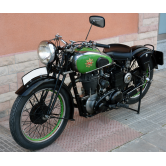No products
Prices are tax excluded
Detailed privacy of the user registry: Here
Legal notice and detailed cookies policy. By continuing to use the site, you accept our use of cookies: Find out more.
226.1
Refurbished
Year of manufacture: 1937.
First registration: 1958
Tuition National. Madrid.
Engine: 500cc. ITV the day.
In perfect state of functioning.
This product is no longer in stock
Warning: Last items in stock!
Availability date:

BSA Empire Star 500cc 1937.
Year of manufacture: 1937.
First registration: 1958
Tuition National. Madrid.
Engine: 500cc. ITV the day.
In perfect state of functioning.
Recipient :
* Required fields
or Cancel
| State | SOLD |
BSA Empire Star 500cc 1937 | |
Manufacturer | BSA |
Production | 1936-1939 |
Class | Standard |
Engine | 249 cc (15.2 inch cubic), 348 cc (21,2 cu in) and 499 cc (30.5 and cu) in a single-cylinder, 4-stroke |
Transmission | 4-speed, chain |
The Empire Star was a standard motorcycle made by BSA at their factory in Small Heath, Birmingham . Named to commemorate the silver Jubilee of king George V of the United Kingdom and is advertised as the masterpiece of the Industry, the range Star Empire was produced between 1936 and 1939, when it became the BSA Gold Star and World War II stopped the production.
Development
Developed from the popular BSA Blue Star and designed by Val Page , the range Star Empire had the benefit of several ideas Page had been developed in their previous employers, Ariel and Triumph motorcycles. With a frame and heavy iron barreled push rod valves of the Empire Star still had the legacy of the earlier BSAs however, and continued to Page to download and introduce the ideas of optimization of the engine during the entire production.
The valve head to the Empire Star was available as the 250 cubic centimetres (15 cu in) 'B22', the 350 cc (21 cu in) "R5 'and the 500 cc (31 cubic inches) models" Q8 ". Based on the standard of the blue star of the "Empire" offered a chaincase primary alloy with a high piston compression special and an inside diameter of the cylinder is hardened. It also had some modern features, including a new gearbox foot change and dry sump lubrication.
BSA launched the range of models Empire Star in 1936 with an effective demonstration of their reliability - a 500 cubic centimeters (31 cu in) model was subjected to an endurance test of 500 miles (800 km) at Brooklands , averaging speeds of over 70 miles per hour (110 km / h) around the oval track. This was followed by a 1,000 miles (1,600 km) endurance race across the Uk, visiting the west country , Wales and the lakes region . The entire trip is successfully completed without the need of the spare parts. A major selling point for BSA in an increasingly competitive market
The outbreak of the Second World War ended the production of the Empire Star in 1939 as the factory of the BSA went on to make the ammunition and the production of the BSA M20 for the british army .
To compete successfully
It was the top of the range 496 cubic centimeters (30,3 cu in) Star Empire, which saw more success in the competition. In 1937 at Brooklands race track, Isle of Man TT winner Wal Handley won a race with a fast lap to 107,57 miles per hour (173,12 km / h) in a specially modified 500 cc Empire Star. The motorcycle used by Handley had a carburetor racing special, a new design of magneto and a close ratio of leverage. Handley had been persuaded out of "retirement" especially for the race of three laps, which meant 8 miles (13 km) to the maximum speed on the uneven and deterioration of oval track banked. It took skill and experience to win, and Handley was awarded one of the badges traditional Gold Star. This inspired BSA to develop the BSA Gold Star.
Also in 1937 BSA racing team rider, Bert Perrigo won trials in both of the Cup Colmore and the Cup of Victory in a B25, Empire Star.
No customer reviews for the moment.